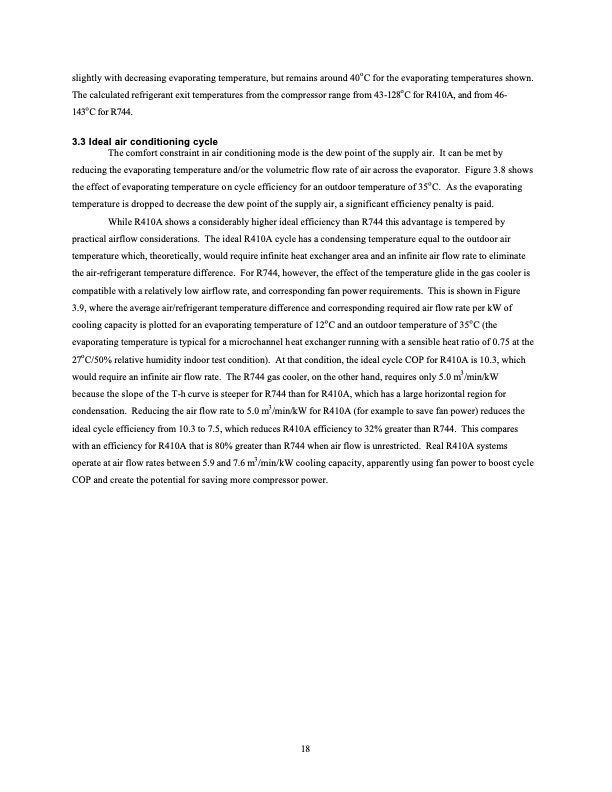
PDF Publication Title:
Text from PDF Page: 029
slightly with decreasing evaporating temperature, but remains around 40oC for the evaporating temperatures shown. The calculated refrigerant exit temperatures from the compressor range from 43-128oC for R410A, and from 46- 143oC for R744. 3.3 Ideal air conditioning cycle The comfort constraint in air conditioning mode is the dew point of the supply air. It can be met by reducing the evaporating temperature and/or the volumetric flow rate of air across the evaporator. Figure 3.8 shows the effect of evaporating temperature on cycle efficiency for an outdoor temperature of 35oC. As the evaporating temperature is dropped to decrease the dew point of the supply air, a significant efficiency penalty is paid. While R410A shows a considerably higher ideal efficiency than R744 this advantage is tempered by practical airflow considerations. The ideal R410A cycle has a condensing temperature equal to the outdoor air temperature which, theoretically, would require infinite heat exchanger area and an infinite air flow rate to eliminate the air-refrigerant temperature difference. For R744, however, the effect of the temperature glide in the gas cooler is compatible with a relatively low airflow rate, and corresponding fan power requirements. This is shown in Figure 3.9, where the average air/refrigerant temperature difference and corresponding required air flow rate per kW of cooling capacity is plotted for an evaporating temperature of 12oC and an outdoor temperature of 35oC (the evaporating temperature is typical for a microchannel heat exchanger running with a sensible heat ratio of 0.75 at the 27oC/50% relative humidity indoor test condition). At that condition, the ideal cycle COP for R410A is 10.3, which would require an infinite air flow rate. The R744 gas cooler, on the other hand, requires only 5.0 m3/min/kW because the slope of the T-h curve is steeper for R744 than for R410A, which has a large horizontal region for condensation. Reducing the air flow rate to 5.0 m3/min/kW for R410A (for example to save fan power) reduces the ideal cycle efficiency from 10.3 to 7.5, which reduces R410A efficiency to 32% greater than R744. This compares with an efficiency for R410A that is 80% greater than R744 when air flow is unrestricted. Real R410A systems operate at air flow rates between 5.9 and 7.6 m3/min/kW cooling capacity, apparently using fan power to boost cycle COP and create the potential for saving more compressor power. 18PDF Image | Comparison of R744 and R410A

PDF Search Title:
Comparison of R744 and R410AOriginal File Name Searched:
CR039.pdfDIY PDF Search: Google It | Yahoo | Bing
CO2 Organic Rankine Cycle Experimenter Platform The supercritical CO2 phase change system is both a heat pump and organic rankine cycle which can be used for those purposes and as a supercritical extractor for advanced subcritical and supercritical extraction technology. Uses include producing nanoparticles, precious metal CO2 extraction, lithium battery recycling, and other applications... More Info
Heat Pumps CO2 ORC Heat Pump System Platform More Info
| CONTACT TEL: 608-238-6001 Email: greg@infinityturbine.com | RSS | AMP |